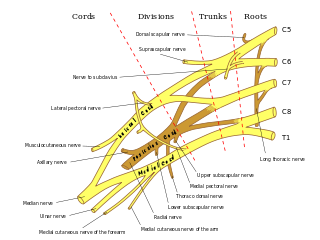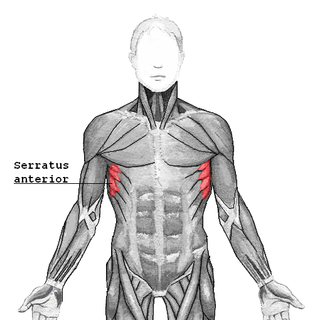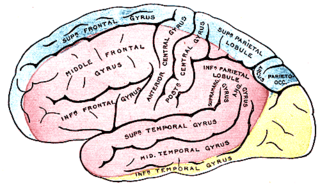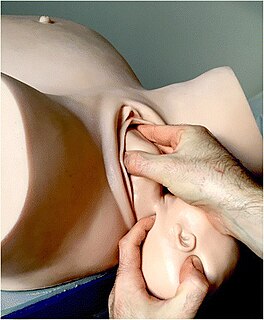
The humerus is a long bone in the arm that runs from the shoulder to the elbow. It connects the scapula and the two bones of the lower arm, the radius and ulna, and consists of three sections. The humeral upper extremity consists of a rounded head, a narrow neck, and two short processes. The body is cylindrical in its upper portion, and more prismatic below. The lower extremity consists of 2 epicondyles, 2 processes, and 3 fossae. As well as its true anatomical neck, the constriction below the greater and lesser tubercles of the humerus is referred to as its surgical neck due to its tendency to fracture, thus often becoming the focus of surgeons.

The axillary nerve or the circumflex nerve is a nerve of the human body, that originates from the brachial plexus at the level of the axilla (armpit) and carries nerve fibers from C5 and C6. The axillary nerve travels through the quadrangular space with the posterior circumflex humeral artery and vein.

The deltoid muscle is the muscle forming the rounded contour of the human shoulder. It is also known as the 'common shoulder muscle', particularly in other animals such as the domestic cat. Anatomically, it appears to be made up of three distinct sets of fibers though electromyography suggests that it consists of at least seven groups that can be independently coordinated by the nervous system.

The posterior cranial fossa is part of the cranial cavity, located between the foramen magnum and tentorium cerebelli. It contains the brainstem and cerebellum.

The serratus anterior is a muscle that originates on the surface of the 1st to 8th ribs at the side of the chest and inserts along the entire anterior length of the medial border of the scapula. The serratus anterior acts to pull the scapula forward around the thorax. The muscle is named from Latin: serrare = to saw, referring to the shape, anterior = on the front side of the body.

The posterior cerebral artery (PCA) is one of a pair of arteries that supply oxygenated blood to the occipital lobe, part of the back of the human brain. It begins near where the posterior communicating artery and the basilar artery join, and connects with the middle cerebral artery of the same side and internal carotid artery via the posterior communicating artery.

In human anatomy, the left and right posterior communicating arteries are arteries at the base of the brain that form part of the circle of Willis. Each posterior communicating artery connects the three cerebral arteries of the same side. Anteriorly, it connects to the internal carotid artery (ICA) prior to the terminal bifurcation of the ICA into the anterior cerebral artery and middle cerebral artery. Posteriorly, it communicates with the posterior cerebral artery.

A dislocated shoulder is when the head of the humerus is out of the shoulder joint. Symptoms include shoulder pain and instability. Complications may include a Bankart lesion, Hill-Sachs lesion, rotator cuff tear, or injury to the axillary nerve.

A Cable fly or Cable flye is a strength training exercise in which the hand and arm move through an arc while the elbow is kept at a constant angle. Flies are used to work the muscles of the upper body. Because these exercises use the arms as levers at their longest possible length, the amount of weight that can be moved is significantly less than equivalent press exercises for the same muscles . Due to this leverage, fly exercises of all types have a large potential to damage the shoulder joint and its associated ligaments and the tendons of the muscles connecting to it. They should be done with caution and their effects first tested while using very light weights; which are gradually incremented after more strength is gained.
Woods' screw maneuver is practiced in obstetrics when dealing with shoulder dystocia—a condition in which the fetal shoulders cannot easily pass through the vagina. In this maneuver the anterior shoulder is pushed towards the baby's chest, and the posterior shoulder is pushed towards the baby's back, making the baby's head somewhat face the mother's rectum.
In obstetrics, position is the orientation of the fetus in the womb, identified by the location of the presenting part of the fetus relative to the pelvis of the mother. Conventionally, it is the position assumed by the fetus before the process of birth, as the fetus assumes various positions and postures during the course of childbirth.

In obstetrics, the presentation of a fetus about to be born refers to which anatomical part of the fetus is leading, that is, is closest to the pelvic inlet of the birth canal. According to the leading part, this is identified as a cephalic, breech, or shoulder presentation. A malpresentation is any presentation other than a vertex presentation.

A shoulder presentation refers to a malpresentation at childbirth where the baby is in a transverse lie, thus the leading part is an arm, shoulder, or the trunk. While a baby can be delivered vaginally when either the head or the feet/buttocks are the leading part, it usually cannot be expected to be delivered successfully with a shoulder presentation unless a cesarean section (C/S) is performed.

A cephalic presentation or head presentation or head-first presentation is a situation at childbirth where the fetus is in a longitudinal lie and the head enters the pelvis first; the most common form of cephalic presentation is the vertex presentation where the occiput is the leading part. All other presentations are abnormal (malpresentations) which are either more difficult to deliver or not deliverable by natural means.
Jobe's test, also known as the relocation test and empty can test, is an orthopedic examination used to test stability of the shoulder.
Mauriceau–Smellie–Veit maneuver or Mauriceau maneuver is an obstetric or emergent medical maneuver utilized in cases of breech delivery. This procedure entails suprapubic pressure by one obstetrician on the mother/uterus, while another obstetrician inserts left hand in vagina, palpating the fetal maxilla using the index and middle finger and gently pressing on the maxilla, bringing the neck to a moderate flexion. The left hand's palm should rest against the fetus' chest, while the right hand can grab either shoulder of the fetus and pull in the direction of the fetus' pelvis. The combined neck flexion, traction on the fetus toward the hip/pelvis, and the suprapubic pressure on the mother/uterus allows for delivery of the head of a breech infant, granted prior breech delivery steps are followed and the infant's occipitus is rotated/facing anteriorly relative to the mother.

The pelvis is either the lower part of the trunk of the human body between the abdomen and the thighs or the skeleton embedded in it.

Rubin maneuver, also known as reverse Woods maneuver, is a secondary, rotational maneuver to deliver the baby in case of shoulder dystocia. The first Rubin maneuver is the rotation of anterior shoulder under pubic symphysis by giving suprapubic pressure. As a result, the bisacromial diameter is rotated from anteroposterior to oblique lie. The obstetrician uses the right hand for performing this maneuver if the foetus is facing mother's right side, and vice versa. During first Rubin maneuver, fundal pressure should not be applied because it may cause uterine rupture or further impaction of the shoulder. If the first Rubin maneuver does not disengage the shoulder, second Rubin maneuver is performed.















